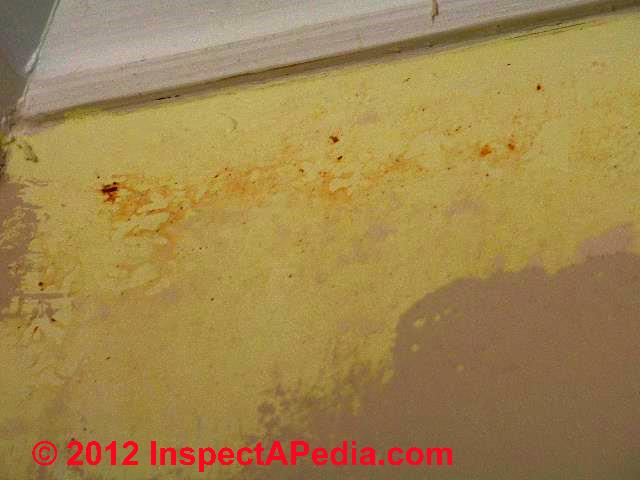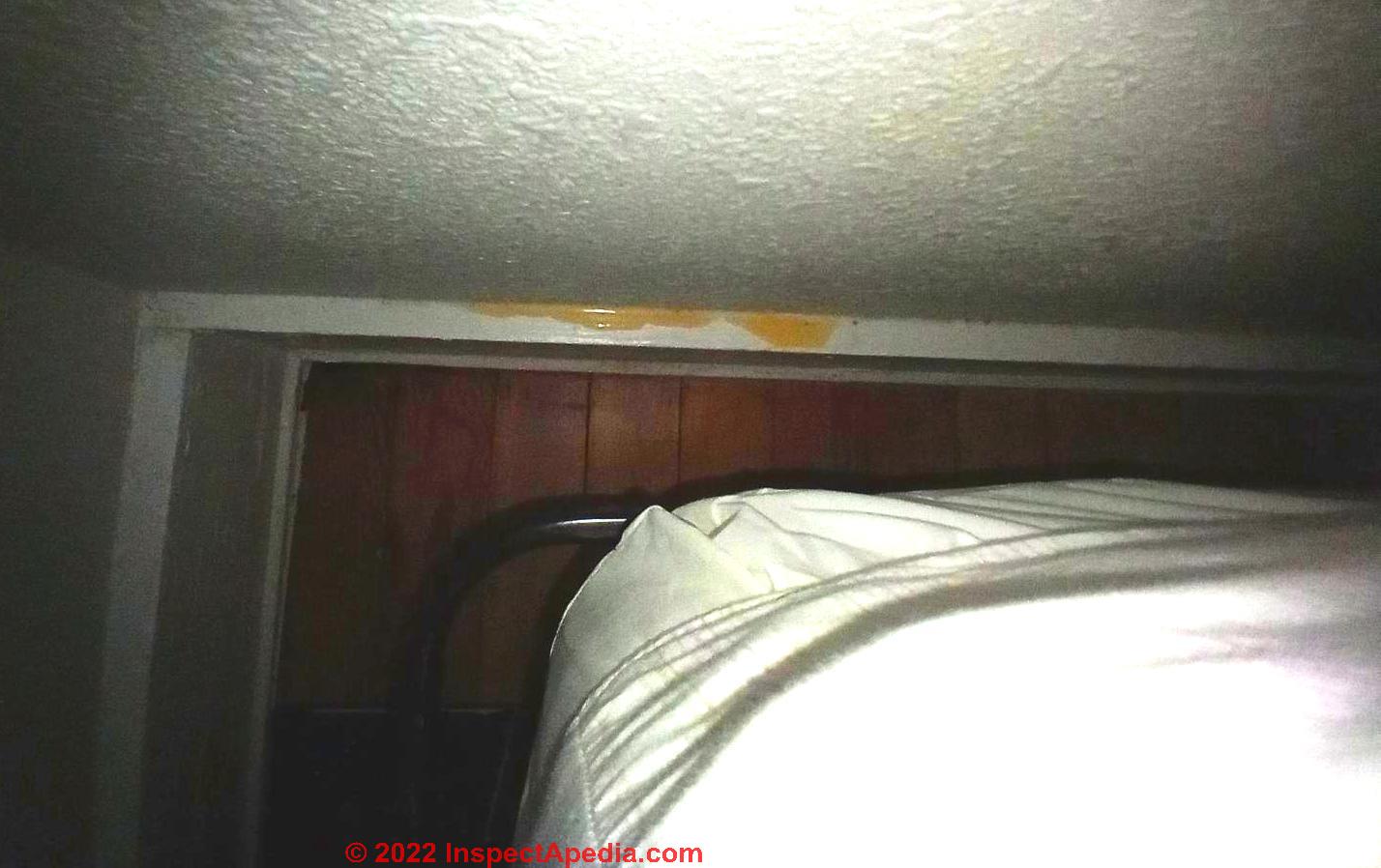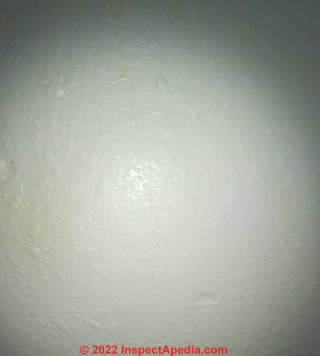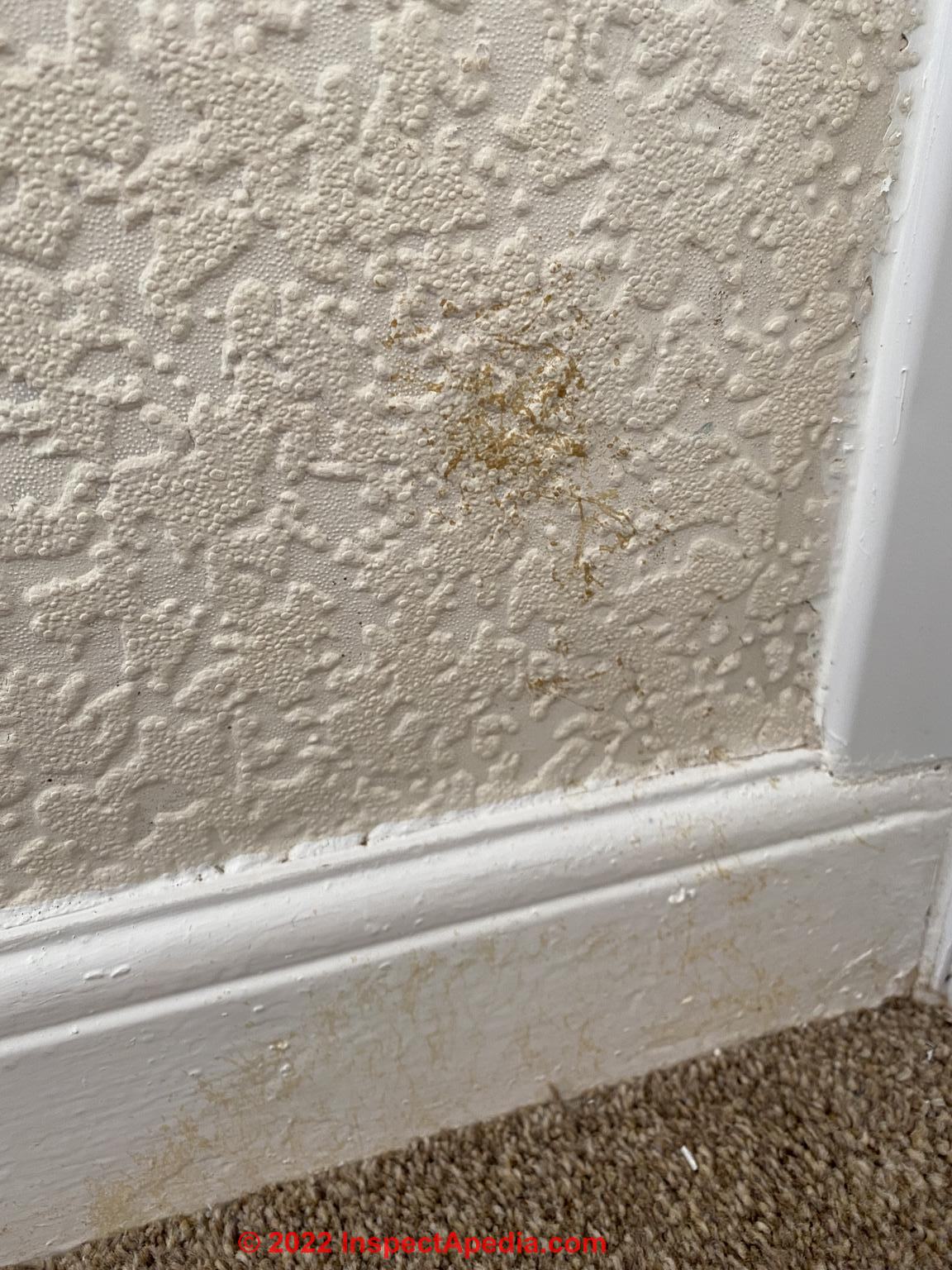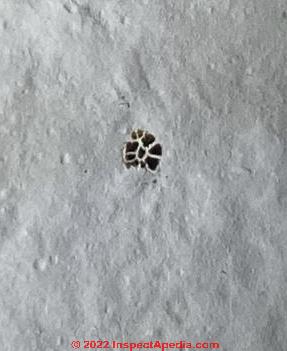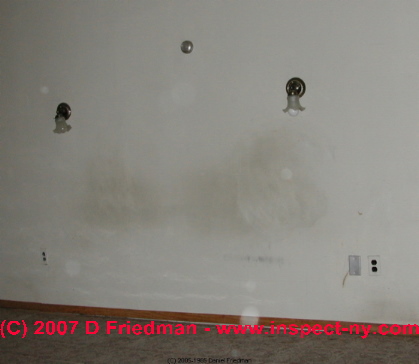 Occupant Stains & Smudges in Buildings
Occupant Stains & Smudges in Buildings
How to Identify, Diagnose, and Remove
- POST a QUESTION or COMMENT about identifying building stains traced to people and occupancy
Dark indoor stain diagnosis:
Human or pet occupants: this article describes & diagnoses the cause of various how to recognize (and clean or prevent) stains and smudges on interior walls when these marks are caused by human occupants.
Examples of human-caused indoor stains include soiling from a person's head leaning against a light-colored wall or brown stains due to cigarette smoking.
When investigating a building for a mold problem, you can save mold test costs by learning how to recognize stains that are basically harmless.
Don't waste money testing these stains. These are indoor marks and substances that you can easily learn to recognize.
InspectAPedia tolerates no conflicts of interest. We have no relationship with advertisers, products, or services discussed at this website.
- Daniel Friedman, Publisher/Editor/Author - See WHO ARE WE?
How to Recognize Wall Stains from Human Occupants
Save your mold test money, and increase the accuracy of your mold contamination inspection or test for toxic or allergenic mold in buildings: review these items to learn recognize non-fungal materials or even possibly harmless cosmetic "black mold" often mistaken for "toxic fungal growth."
Black marks on interior walls such as painted drywall might be also be dark wall stains where people rested their heads in bed (as shown in this photo at left).
 Look at the location of these stains and imagine a bed having been placed with its head against the wall shown in the
photograph. Notice the two wall lights.
Look at the location of these stains and imagine a bed having been placed with its head against the wall shown in the
photograph. Notice the two wall lights.
This is where a bed was almost certainly placed, and we can easily explain these black stains on the drywall. No further testing would be appropriate in normal circumstances.
We welcome more thermal tracking, soot tracking, air bypass leaks, and similar photos of indoor stains as well as text suggestions to expand this detail and would be glad to credit contributors.
Usually soot marks, thermal bridging, or thermal tracking stains appear, if at all, in the building interior locations discussed in the remaining sections of this article.
Cigarette, Cigar or Pipe Smoker Stains in Buildings
Shown in the photo above:
We have inspected a number of buildings inside which we observed brown nicotine/smoke stain patterns traced to smokers.
First, brown-colored stains that appear either uniformly or in thermal-tracking streaks on walls and ceilings.
Often these cigarette smoke stains are found principally in one or two rooms of a home occupied by smokers - rooms where, obviously, people spent more time smoking such as in a living room around a couch or recliner chair, or in bedrooms.
Watch out: smoking in bed is a well-known fatal fire hazard
In these homes, the observation that brown stains are found in just these occupied spaces is an argument against other causes that would produce more uniform staining, such as heating system problems or poor building wall or ceiling insulation.
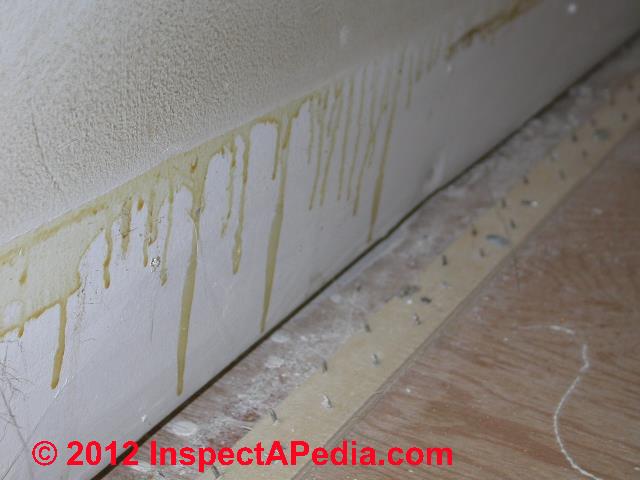
Our wall stain photos above illustrate a second instance, we find brown stains that appear to run in rivulets down building walls. This is essentially the same cause, and these stains will appear most severe in the same locations we described above.
The difference is that there have also been occasions of very high indoor moisture or even wet conditions in the "brown rivulet streak stain" homes. Moisture that condenses at high levels on a building wall will eventually produce droplets that run down the wall.
The dissolved nicotine and tobacco smoke stains are concentrated and redistributed by these moisture drip marks. Or conversely, we may see a tan-stained wall with clean rivulet areas where water droplets have carried stain material away.
Even when the interior wall has later been cleaned of smoke tar and nicotine marks, we may find remains of that material behind baseboard trim.
Watch out: any soiling on building walls can leave rivulet-pattern stains if the wall has been wet for any reason.
Mottled Pattern Indoor Smoker Stains
Sometimes, depending on the water deposition pattern on building walls, these smoker stains may appear mottled in pattern rather than streaked.
Watch out: Mottled wall or ceiling stains may also appear not from smoking indoors but from building leaks that dissolve brown ingredients in wall, ceiling or floor cavity framing or insulating materials.
We've also found this condition in a room where someone attempted to wash a cigarette or cigar smoke stained ceiling or wall, using insufficient water or cleaner or other poor methods.
At HEAT LOSS INDICATORS we also discuss and describe brown stains found on building ceilings and walls that are traced to smokers.
That is, areas in buildings where people have spent time smoking cigarettes, pipes, or cigars.
Brown deposits blamed on smokers traced to unsafe gas furnace!
Question: a "sweet" strange smell in my house and brown dust
2017/01/04: anonymous (by private email) asked:
I am very concerned about a "sweet" strange smell in my house. I just bought the 11 year old house, it has a propane forced air furnace. I have washed every surface and I'm having the interior repainted.
What concerns me is the smell continues at irregular intervals and produces a tan granular dust. This discoloration is on light switches and outlets.
The realtor said the previous owners were smokers and that was the cause for this smell and the dust material being everywhere. Help. I don't know what to do. My attempts so far seem to be failing. - Anon in Michigan
Reply: suggestions for sealing stains and odors left by smokers vs. diagnosing powdery dust deposits
Smoking leaves a sticky, tarry brown deposit on indoor surfaces but not a powdery dust. The smoking deposit can be wiped off but usually with difficulty unless using a liquid cleaner that acts as a solvent. Even then in my experience that won't eliminate smoking-related odors.
At FIRE & SMOKE ODOR REMOVAL we discuss the use of sealants to manage odors and stains left in buildings after cleaning has proved insufficient.
In a home where there were heavy smokers I've found it necessary to first clean all interior surfaces: ceilings, walls, cabinets, trim, etc., and then I might have to paint ceilings and walls, possibly trim, with an odor-sealing paint such as types used after fires in buildings.
See MOLD SANITIZER, SPRAY, BIOCIDE USE GUIDE to see examples and products.
You might want to use such a sealer as your primer coat before re-painting. Particularly, I use a lacquer primer sealer over bad stains that might otherwise bleed through even multiple coats of latex and even some alkyd paints.
Plastic switch and receptacle covers should be removed for a decent paint job anyway. Soak them in a household cleaning solution and then use a green scrubby sponge to clean them and let them dry before reinstalling - or if labor gets excessive just replace them.
Look for the source of the tan dust
The tan dust, if that is really recurring, is a different problem and we need to track down its source. I'd look at particle and dust or debris sources, starting with any fuel burning appliances.
Watch out: gas fired appliances, in particular, that are putting out dust or debris are unsafe. A minimum safety step besides inspection for trouble signs would be the installation of smoke and CO detectors.
See CARBON MONOXIDE - CO and also
see CARBON MONOXIDE HEATING SYSTEM CHECK
At the top of any InspectApedia page where you
see EXPERTS DIRECTORY you might find an IAQ consultant or inspector who can do some useful consulting or onsite work. I'll offer a few comments, questions, suggestions pro-bono.
Reader follow-up: sand and dirt sucked into the furnace mounted on a dirt/sand crawl space floor spreads tan dust through building
I thought I'd get back to you about the "tan dust" question I posed previously. Some time in the past an air conditioning coil was added to the heating system. In order to add the ac, the furnace had to be lowered and was set on a couple of 2" paving blocks which put the furnace right at the level of the crawl space sand floor.
Over time, sand/dust was sucked into the furnace, circulated, some exited through un-sealed duct joints and due to static electric charge, clung to the Styrofoam used to insulate the block in the crawl space. I taped and sealed all of the duct joints and had a sealed vapor barrier placed over the entire crawl space floor.
I previously had the ducts cleaned (hind sight would have reversed the order) and hope that by running the furnace fan, constantly changing the filter and providing lots of outside air to the main floor of the house the system will eventually "air out" and the problem will be solved.
Reply:
Thank you for this update - that's certainly a problem that I'd not have guessed.
There are further implications from what you've told me. Return air should not be drawn in at the furnace in any event.
Watch out: taking return air at the furnace risks (for gas systems at least) fatal carbon monoxide poisoning, and both gas and oil systems, improper burner operation. Sufficient negative pressure around the air handler / furnace to draw in local sand, debris, grit, dust, tells me that the system is probably starved for - has inadequate - return air from the occupied building space.
An effect of that inadequacy is less effective heating or cooling and higher heating and cooling costs.
See RETURN AIR REGISTERS & DUCTS
and also
Reader follow-up: Carbon Monoxide Poisoning from return air inlet at furnace
You keep nailing my situation. Last Tuesday I took sick and found out I had elevated carbon monoxide (0 - 1.5 normal for non smoker, I was 2.6). I had paid a heating contractor to check my furnace in December (I specifically asked him to check the exchanger as Lennox had problems a few years back with cracked exchangers).
He said all was fine and put in some new burners.I found out last week that I did indeed have a cracked exchanger and opted to replace the furnace. The first contractor said he would "make it right with me financially." So, I will see.
Reply: importance of carbon monoxide and smoke detectors
Watch out: Be sure you have working CO detectors properly located, installed, tested as even with new equipment, something can still go wrong, such as a chimney blockage, inadequate combustion air, or return air interference at the heater.
...
Reader Comments, Questions & Answers About The Article Above
Below you will find questions and answers previously posted on this page at its page bottom reader comment box.
Reader Q&A - also see RECOMMENDED ARTICLES & FAQs
On 2022-04-28 by LLI
Hey there, I'm curious about some orange/tan streaks in one of our bedrooms. We bought the house a year ago, at which point it had been recently painted. My first thought was nicotine stains from a previous owner, but we only noticed the stains after running a humidifier on high.
In the morning, the stains had streaked down the walls and pooled on the baseboards as shown in the attached image. It was very easy to clean off. Would this be nicotine? Surfactant leaching? Something else? Our son has been sleeping in the room and I want to make sure it is safe for him. Thanks!
It seemed like whatever it was had dripped down from about midway up our walls... I don't have a great image of the streaks, however.
On 2022-04-28 by Inspectapedia Com Moderator - open the drywall to find source of leak and fix it
@LLI,
It looks as if you have a water leak in that wall cavity
Find and fix the leak - it will be above where the water first appears though not necessarily directly (straight line) above
Open the drywall to inspect for wet insulation and mold.
Normally all drywall that has been wet needs to be replaced.
On 2022-04-15 by S14
Hi, does anyone know what has caused these marks on skirting boards and wallpaper?
On 2022-04-15 by Inspectapedia Com Moderator
@S14,
That could be a fungus - on enlarging the photo it's a bit blurry so I'm unsure
Your photo confirms your mention of the skirting board (baseboard trim) marks that appear to be similar though lighter, markings at floor level, over a wider area, as if that was previously wet.
Encouraging is that the stain or growth appears to originate on the room side, not from within the wall cavity.
On 2021-11-17 by Kris
Hey y’all! Thanks for taking to time to look this over. They’re all over, different sizes and “designs” but generally like the one shown. Light yellow to the color of the one in pic. Any ideas! Please!!
On 2021-11-17 by Inspectapedia Com Moderator
@Kris,
I looked at your photo and even try to zoom in but I can't quite make out what that is,
if you are referring to that funny Dark Spot. Might be a fungal growth or something else.
On 2021-08-01 by M Rob
I have brown spots on my living room wall that look like grease spots. What are they and how do I get rid of them?
On 2021-08-02 by inspectapedia.com.moderator - how can I get rid of grease spots on my wall?
@M Rob,
Often if there are grease spots on a wall like that you can seal the wall with a lacquer primer sealer and then paint with a finish coating
On 2018-12-16 by Natalia
First marks appeared on the interior drywall 2 years after the house was build. Within the year the number of these marks increased. The marks are located mostly on the lower half of the wall, appear only on one side of the wall, and are shining if to look at them under the angle of if to use a flashlight.
The drywall specialist said that he sees something like this for the first time. I did not find anything similar in the internet. The images are attached. Thanks for help.
On 2018-12-19 by danjoefriedman (mod)
Natalia
I took a look at your photo, though it's a bit blurry and hard to make out. I can't tell for sure but it almost looks as if something was splashed on the wall.
You could try cleaning the surface. Also you could tell me if it feels damp. And if you want to detect the possibility of a leak behind the wall that's creating those spots, you could perhaps mark the edges of the spots so that you can see if they're growing or changing in shape.
Question: how to prevent indoor stains similar to cigar or smoke stains
(Jan 14, 2015) Denise said:
Hi, I'm a property manager and I have experienced stains that are similar to cigar and smoke stains. We have used some cleaning methods. How do you prevent this?
Reply:
Denise,
You can keep indoor humidity levels down, insulate walls, use a paint that is washable, and beyond that you'd have to prohibit smoking, fires, scented candles, pets, and dusty activities.
Question: blackish mold patches near the ceiling on my bathroom wall
(Mar 8, 2016) Aundrea said:
I have a blackish mild forming in patches near the ceiling on my bathroom wall. My apartments maintenance man says it is caused by previous tenants that smoked in the bathroom.
I find this hard to believe. We moved in Nov 2004, noticed the walls weeping a yellow substance, obvious nicotine. But the molding didn't show up until the start if 2012. The maintenance man says that some molds can take a while to show up. My question...CAN nicotine cause black mold? (I do not think this is the dangerous black mold..but then again nobody has tested it).
Reply:
Aundrea
If mold is growing because of a leak from above, the ceiling may need to be opened, wet drywall and insulation removed, the cavity cleaned, the leak source corrected, and the ceiling restored.
If mold is growing because your bathroom doesn't vent or isn't being vented (vent fan or open windows) during those long hot steamy showers, then you need to fix or use the vent system.
Nicotine does not cause mold growth.
"Dangerous black mold" is misleading and often a scare tactic. Among the millions of mold genera/species there are both harmless molds that are "black", and there are very dangerous molds found indoors on building materials that may be red, white, blue, green, yellow, brown, gray, etc.
...
Continue reading at ANIMAL STAINS & MARKS in BUILDINGS or select a topic from the closely-related articles below, or see the complete ARTICLE INDEX.
Or see these
Recommended Articles
- ANIMAL STAINS & MARKS in BUILDINGS
- FIRE & SMOKE ODOR REMOVAL - home
- ODORS GASES SMELLS, DIAGNOSIS & CURE - home
- STAIN DIAGNOSIS on BUILDING INTERIORS - home
- THERMAL TRACKING BRIDGING GHOSTING - home
Suggested citation for this web page
STAINS HUMAN OCCUPANT at InspectApedia.com - online encyclopedia of building & environmental inspection, testing, diagnosis, repair, & problem prevention advice.
Or see this
INDEX to RELATED ARTICLES: ARTICLE INDEX to BUILDING STAINS
Or use the SEARCH BOX found below to Ask a Question or Search InspectApedia
Ask a Question or Search InspectApedia
Try the search box just below, or if you prefer, post a question or comment in the Comments box below and we will respond promptly.
Search the InspectApedia website
Note: appearance of your Comment below may be delayed: if your comment contains an image, photograph, web link, or text that looks to the software as if it might be a web link, your posting will appear after it has been approved by a moderator. Apologies for the delay.
Only one image can be added per comment but you can post as many comments, and therefore images, as you like.
You will not receive a notification when a response to your question has been posted.
Please bookmark this page to make it easy for you to check back for our response.
IF above you see "Comment Form is loading comments..." then COMMENT BOX - countable.ca / bawkbox.com IS NOT WORKING.
In any case you are welcome to send an email directly to us at InspectApedia.com at editor@inspectApedia.com
We'll reply to you directly. Please help us help you by noting, in your email, the URL of the InspectApedia page where you wanted to comment.
Citations & References
In addition to any citations in the article above, a full list is available on request.
- ASHRAE resource on dew point and wall condensation - see the ASHRAE Fundamentals Handbook, available in many libraries.
- 2005 ASHRAE Handbook : Fundamentals: Inch-Pound Edition (2005 ASHRAE HANDBOOK : Fundamentals : I-P Edition) (Hardcover), Thomas H. Kuehn (Contributor), R. J. Couvillion (Contributor), John W. Coleman (Contributor), Narasipur Suryanarayana (Contributor), Zahid Ayub (Contributor), Robert Parsons (Author), ISBN-10: 1931862702 or ISBN-13: 978-1931862707
- In addition to citations & references found in this article, see the research citations given at the end of the related articles found at our suggested
CONTINUE READING or RECOMMENDED ARTICLES.
- Carson, Dunlop & Associates Ltd., 120 Carlton Street Suite 407, Toronto ON M5A 4K2. Tel: (416) 964-9415 1-800-268-7070 Email: info@carsondunlop.com. Alan Carson is a past president of ASHI, the American Society of Home Inspectors.
Thanks to Alan Carson and Bob Dunlop, for permission for InspectAPedia to use text excerpts from The HOME REFERENCE BOOK - the Encyclopedia of Homes and to use illustrations from The ILLUSTRATED HOME .
Carson Dunlop Associates provides extensive home inspection education and report writing material. In gratitude we provide links to tsome Carson Dunlop Associates products and services.


